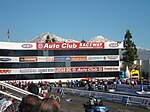The Los Angeles County Fair is an annual county fair. It was first held on October 17, 1922, and ran for five days through October 21, 1922, in a former beet field in Pomona, California. Highlights of the fair's first year were harness racing, chariot races and an airplane wing-walking exhibition. The fair is one of the largest county fairs in the United States. Attendance has topped one million people every year with the exception of three years since 1948, and is the 4th largest fair in the United States. Since its opening year, over 89,000,000 visitors have attended the LA County Fair.Since its inception, the fair has been the link between California’s agriculture industry and the public, providing a community gathering place where people learn about California’s heritage and enjoy traditional fair food, activities and entertainment. In recent years, the fair has moved away from such agricultural heritage by transitioning from livestock competitions for area growers and ranchers to hired petting zoos. In addition to the 13-acre (53,000 m2) Ray Cammack Shows carnival, the fair has an operational farm, an outdoor miniature garden railroad, California’s Heritage Square historical exhibit and America’s Kids-Education Expo. They also have the Flower and Garden Pavillion, a grandstand for shows and several large Expo Halls.The May Concert Series features multiple nights of musical entertainment, including many well-known acts. When the Fair was held in September, there was the "End of Summer Concert Series" which also included motocross and monster truck performances. The fair is operated by the Los Angeles County Fair Association, a non-profit 501(c)(5) corporation. The fair has been regularly held during the end-of-summer months from its inception in 1922 through the 2000s, except for all fairs since 2022, held in May. The fair is built on 543 acres (2.20 km2) of fairgrounds known as Fairplex (Los Angeles County Fair, hotel and exposition complex). This also generates a national economic impact of more than $250 million.The Los Angeles County Fair's mascot "Thummer" was introduced in 1948 as "Porky the Hitchhiking Pig". The artist - Morrie Stewart - originally designed the pig mascot for Kaiser Steel before being approached by the fair to create a new mascot with the re-opening of the fair following World War II. "Porky the Hitchhiking Pig" appeared at the Los Angeles County Fair through 1952 when another cartoon claimed naming rights to the name. The fair held a naming contest through radio and television, and the name "Thummer" was adopted. Thummer has been a regular appearance at the Los Angeles County Fair ever since. Thummer wore his trademark outfit and carried a briefcase through the 1980s when a "Mrs. Thummer" was introduced. Thummer disappeared in the early 1980s, but reappeared in 1988.
Fairplex also includes the Sheraton Fairplex Hotel & Conference Center, the Sheraton KOA/RV Park, Barretts Sales and Racing, a defunct 0.625 mi (1.006 km) horse racing track, the Millard Sheets Art Center, the Child Development Center at Fairplex, the Fairplex railway exhibit, Barretts Equine Ltd., a thoroughbred horse racing auction facility and the Wally Parks NHRA Motorsports Museum.The Los Angeles County Fair was canceled shortly after the 1941 fair due to the outbreak of World War II and re-opened in 1948. The 2020-21 fairs were canceled due to the COVID-19 pandemic in California, deferring, as announced in May 2021, the next fair to May 2022, citing that summer heat resulted in reduced attendance.Patrollers include security guards, the Pomona Police and Los Angeles County Sheriff's Office.









